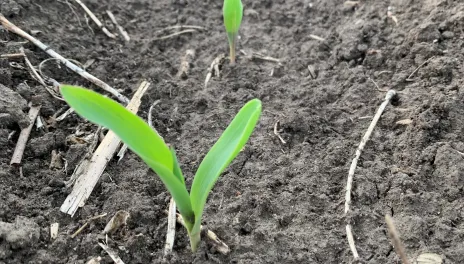Update on CREC Corn Starter and Foliar Fertilizer Research: Phosphorus and Zinc
NDSU recommends starter phosphorus (P) fertilizer for corn, regardless of P soil level.
Starter fertilizer application is defined as either placing in-furrow (IF) or within 2 inches of corn seed during planting, with typical rates of 10-34-0 at 3 gpa. P starter fertilizer provides the potential to increase early season plant growth by increasing nutrient uptake, and ultimately increase grain yield. Starter fertilizer will not satisfy total P needs of corn with soils testing less than medium for P (<8 ppm; Olsen test), thus supplemental P fertilizer (broadcast or deep-band application) would be recommended. Corn is expected to respond to zinc (Zn) fertilizer if soils levels are below 1 ppm. Zn may be applied as preplant broadcast, starter or foliar. P and Zn fertilizer rate recommendations are in the NDSU Extension publication ‘Soil Fertility Recommendations for Corn’.
The CREC began a series of corn field trials in 2007 to document response to starter P fertilizer, primarily using 10-34-0 with various application methods and rates on soils generally testing medium or less for P. Averaged across 8 site-years, IF or 2-inch band applied 10-34-0 at 2.5 to 6 gpa had similar early season plant stands between P application methods, and increased grain yield 4-5% compared to the untreated check. Data and details of research during 2007-2016 are summarized in the NDSU Extension publication ‘Corn Response to P Starter Fertilizer in ND’.
In 2016, the research focus transitioned to tests with Zn, preplant incorporated (PPI), and specialty fertilizers compared to IF-applied 10-34-0 at 2.5-3 gpa in soil with P levels at <8 ppm and Zn at <0.65 ppm. The following is a summary of grain yield response with various fertilizer treatment comparisons using multi-year means through 2021:
- Corn response was similar between IF 10-34-0 and surface-applied band 10-34-0 (4 site-years). Rain totaling >0.3 inches for incorporation of surface-applied fertilizer was delayed >5 days after application among years.
- IF 10-34-0 plus Zn chelate (0.25 gpa) was 4% greater than sole 10-34-0 or the untreated check (5 site-years).
- IF 10-34-0 plus Zn chelate (0.25 gpa) was 3% greater than 10-34-0 followed by foliar-applied Zn chelate (V4-6 growth stage; 4 site-years).
- PPI MESZ (MicroEssentials SZ [12-40-0-10S-1Zn]; Mosaic) was 3% greater than PPI triple super phosphate plus ammonium sulfate (S) plus ZnS, with both treatments containing similar amounts of P, S and Zn on a plant food basis, and followed by IF 10-34-0 (3 site-years).
- IF 10-34-0 plus Zn chelate (0.25 gpa) was 3% greater than IF RiseR (7-17-3-0.95Zn; Loveland Products) at 2.5 gpa (3 site-years).
Corn plant population was similar among all treatments in each trial conducted during 2016-20. However, in the 2021 trial, plant stand was generally reduced (11-16%) with IF 10-34-0 compared to the untreated check, due to dry topsoil during plant establishment. IF starter fertilizer sources and rates need to be considered during adverse soil conditions such as in 2021.
Greg Endres, M.S., CCA
Gregory.Endres@ndsu.edu
Extension Cropping Systems Specialist

